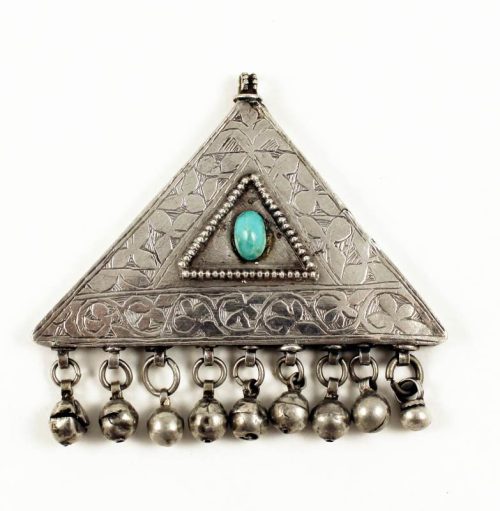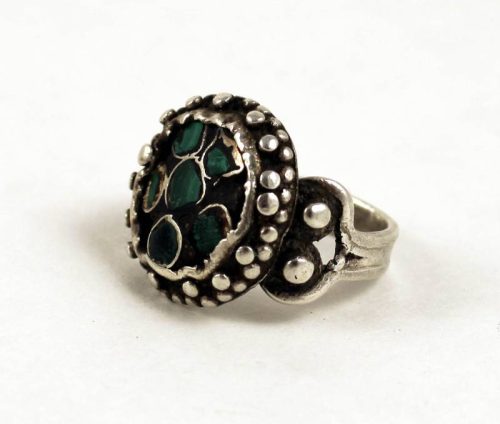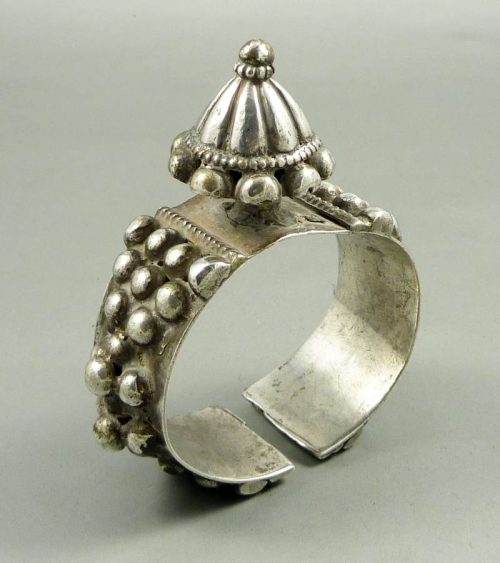-
Yemeni ring made of high-grade silver. This kind of rings are called tower rings, and are also worn by Rashaida women. Age: 1st half of the 20th century. Provenance: UK private collection. Dimensions: Total height of the ring: 4,5 cm Ring size: 18 mm inner diameter - US size 7 3/4 Literature: “Bagues ethniques d'afrique, d'Asie et d'Amerique”, van Cutsem, Anne, Skira, 2000, p. 120 “Africa Adorned”, Fisher, Angela, Collins Harvill, London, 1984, p. 279 ME267
-
This is a twelve-strand necklace of very small glass beads, in a red and yellow combination.This type of necklaces or similar ones are worn by different tribes around the Golden Triangle, in the border between Myanmar, Laos and Thailand, like the Karen people. Also Bonda women from Odisha, India, wear similar necklaces to these, in many rows to cover the front side of the torso. From the beginning of the 20th century. The necklace is approx 80 cm long. In good condition. The strings are old natural fiber, they can be in delicate condition. There's no clasp to fasten it. IND1352
-
A three-strand of small bronze pendants and beads. Each of the pendants (1 cm high) has been cast by the lost wax technique. Most probably Kondh tribal culture, Orisha, India. From the 1st half of the 20th century or earlier. In the original stringing. Provenance: ex UK private collection. Length (longest strand): 78 cm Weight: 107,7 gr IND1636
-
Silver earrings from Nage or Ngada people, Flores, Indonesia. Age: 1st half of the 20th century or earlier. Provenance: German private collection. Dimensions: 3 x 2 x 0,5 cm Weight: 20,1 gr Literature: “A world of earrings. Africa, Asia America”, van Cutsem, Anne, Skira, 2001, p.283 “Sieraden, en lichaamsversiering uit Indonesië”, Wassing, Rita, Museum Nusantara, 1984, p.71 INDO130
-
Vintage Zuni silver and turquoise bracelet, from the Zuni people inhabiting New México (USA). Age:20th century Made of high grade silver and turquoise. Dimensions: Total size: 7 x 5,8 x 2 cm Inner size: 6,3 cm Weight: 56,9 gr Literature: “Bracelets ethniques d'afrique, d'Asie d'Océanie et d'Amérique”, van Cutsem, Anne, Skira, 2002, p. 321 “Indian silver jewelry of the Southwest 1868-1930”, Frank. Larry, Schiffer, 1990 “Turquoise”, Mark P. Block, Schiffer, 2017 “North American Indian jewelry and adornment”, Sherr Dubin, Lois, Harry N. Abrams, 1999 AME13
-
Pair of African bronze anklets, worn by Lobi tribe in Burkina Fasso. From the first half of the 20th century. Provenance: French private collection. Dimensions: 15 x 9 cm Weight: 1068 gr WA172
-
Silver Omani amulet pendant, with etched decoration and small bells at the bottom. Decoration of the back suggests the Oman origin. This piece is rare and looks very similar to some Afghan and Hazara pendants. Materials: silver and turquoise. From the first half of the 20th century. It was sourced in Riadh by the previous owner in the 60s' or 70s'. Provenance: French private collection. Dimensions: 7 x 8 x 0,5 cm Weight: 38,2 gr A similar example from Yemen is in the collection "splendor and Shine" from Germany. ME249
-
High grade silver bracelet in spiral shape narrowing towards the end, used mainly by Wa/Lawa people, one of the Hill Tribes inhabiting the Golden Triangle (SE Asia). Age: First half of the 20th century Provenance: Italian private collection Dimensions: Inner diameter: 6 cm Width: 2 cm Weight: 75,5 gr Literature: “Peoples of the golden triangle”, Lewin, Paul and Elaine, River Books, Bangkok, 1998, p.42 “The art of silver jewellery. From the minorities of China, the Golden Triangle, Mongolia and Tibet”, Skira, 2006, p. 159 “Bracelets ethniques d'afrique, d'Asie d'Océanie et d'Amérique”, van Cutsem, Anne, Skira, 2002, p. 267 “Silver from fetish to fashion”, Nadler, Daniel and Serga, pdn publishing, 2005, p. 327 SEA495
-
A charming silver ring. According to the previous owner the ring is from from Aceh Sumatra (Indonesia).It's decorated with filigree. From the 19th century. Provenance: Belgian private collection. Ring size: US 8 - 18,25 mm inner diameter INDO100
-
Man's silver ring from the Himalayan region, made of high grade silver and a three coral beads. From the first half of the 20th century. Provenance: European private collection. Dimensions: Size of ring: 11 1/4 - 21 mm (inner diameter) Weight: 13,3 gr HIM132
-
Ancient Dong Son bronze bracelet, from Vietnam/Laos. It shows the typical Dong Son motifs of frogs and a procesion of cold and warm bblooded creatures. Reptiles inhabit the underworld realms of earth and water and also the earthy domain shared by mammals and human beings. Provenance: European private collection. Dimensions: External diameter: 9 cm Inner diameter: 6,5 cm Width: 0,9 cm Weight: 75,4 gr Literature: “Bracelets ethniques d'afrique, d'Asie d'Océanie et d'Amérique”, van Cutsem, Anne, Skira, 2002, p. 276 “The jewelry of Southeast Asia”, Richter, Anne, Thames & Hudson, 2000, p. 29 SEA502
-
Silver filigree ring from Yemen, with dangles to ward off the evil eye and one coral bead at the top of one of the domes (the other one is missing). Beginning of the 20th century or earlier Provenance: European private collection. Size is US 9 - 19 mm inner diameter. Literature: “Bagues ethniques d'afrique, d'Asie et d'Amerique”, van Cutsem, Anne, Skira, 2000, p. 98 ME279
-
Silver ring from Yemen (high grade silver). From the beginning of the 20th century or earlier. Provenance: European private collection. Size is US 5 1/4 - 16 mm inner diameter) Literature: “Bagues ethniques d'afrique, d'Asie et d'Amerique”, van Cutsem, Anne, Skira, 2000, p. 98 “Silver treasures from the land of Sheba”, Ransom. Marjorie, The American university in Cairo Press, 2014, p. 146 ME276
-
Silver ring from Yemen (high grade silver). From the beginning of the 20th century or earlier. Provenance: European private collection. Size is US 6 - 16,5 mm inner diameter) Literature: “Bagues ethniques d'afrique, d'Asie et d'Amerique”, van Cutsem, Anne, Skira, 2000, p. 98 “Silver treasures from the land of Sheba”, Ransom. Marjorie, The American university in Cairo Press, 2014, p. 146 ME275
-
Ethnic earrings from the Dong people, living in Guizhou, South China. From the beginning to mid 20th century. Fine filigree work and high-quality silver, with a wonderful patina. The earrings were filled at some point with wool for decoration. In a fairly good state, just one of the small silver balls is missing. They are 6 cm long (2,36 in) and they both weigh 28 gr. SEA238
-
Solid bracelet, made of high-grade silver (tested). From Sindh region in Pakistan. From the first half of the 20th century or earlier. Dimensions: Size: 9,5 x 7,5 cm Inner diameter: 6 cm Weight: 132,6 gr Literature: “Schmuck in Afganisthan”, Janata, Alfred, Akademische Druck, 1981 CA21
-
Pair of moulded and chased fibulas from Essaouira, Morocco, worn by the Ait Haha people. These fibulas were collected in the mid of the last century by a Spanish doctor living in the area. The shape is a remainder of a ram’s head, which is a very important animal since pre-historic times. From early 20th century. It is hallmarked as Essaouira 1332 (1913) and a rooster head on the back. Dimensions: 13 x 8,5 cm Weight: 97,1 gr Literature: “Bijoux Berbéres Au Marroc dans la tradition judeo-arab”, Rouach, David, ACR Edition, 1989, p. 110 “Les fibules, deux mille ans en Afrique du N”, Rabaté. Marie-Rose, ACR Edition, 2013, p. 183 “Berber Memoires”, Draguet, Michel, Mercator fonds, Yale, 2021, p. 117 ss “Bijoux du Marroc. Du Haut Atlas à la Vallée du Draa”, Rabaté, Marie-rose et Jacques, Edisuc/Le Fennec, 1996, p. 163 MAR271
-
Silver ring from the Himalayan region. Made of high grade silver and a big red glass bead. From the first half of the 20th century. Provenance: Belgian private collection. Dimensions: Top of the ring: 2,8 cm Size of ring: US 7 (17,25 mm inner diamenter) Literature: “Bagues ethniques d'afrique, d'Asie et d'Amerique”, van Cutsem, Anne, Skira, 2000, p. 155 “Ethnic jewellery and adornment” Daalder, Truus, Ethnic Art Press, 2009, p. 291 “Ethnic jewellery from Africa, Asia and the Pacific Islands”, The pepin Press, 2002, p.173 “Jewellery of Tibet and the Himalayas”, Clarke, John, Harry N. Abrams. Inc publishers, 2004, p. 25 “Traditional jewelry of India”, Untracht, Oppi, Harry N. Abrams. Inc publishers, 1997, p. 155 HIM112
-
High grade silver and turquoise ring, either from Central Asia or from Saudi Arabia. From he first half of the 20th century. Provenance: European private collection. Size: Ring size 8 1/2 or 18,75 inner diameter Top of the ring: 2 cm ME265
-
Pair of silver flexible “paizebh” anklets from India. High-grade silver. From mid-XXth Century. They can be opened easily with a pin. This kind of flexible Indian anklets look lighter and more frivolous than the rigid pieces that can be found in other regions in India, but they are usually heavier than they appear to be. Women in traditional Central India usually wear several flexible and rigid anklets on each leg at the same time. Check the post about Indian anklets in my blog for more information. Dimensions: Length: 30,5 cm Width (with dangles): 1,7 cm Combined weight: 98,5 gr. Literature: “Indian Jewellery”, Holbein Hendley, Thomas, BR publication, Delhi, 2009 “Rajasthan's silver jewellery”, Pandey, Tripti, Rupa &co,, New Delhi, 2003 IND1577
-
Pair of silver flexible “paizebh” anklets from India. High-grade silver. From mid-XXth Century. They can be opened easily with a pin. This kind of flexible Indian anklets look lighter and more frivolous than the rigid pieces that can be found in other regions in India, but they are usually heavier than they appear to be. Women in traditional Central India usually wear several flexible and rigid anklets on each leg at the same time. Check the post about Indian anklets in my blog for more information. Dimensions: Length: 27,5 cm Width (with dangles): 1,2 cm Combined weight: 94,5 gr. Literature: “Indian Jewellery”, Holbein Hendley, Thomas, BR publication, Delhi, 2009 “Rajasthan's silver jewellery”, Pandey, Tripti, Rupa &co,, New Delhi, 2003 IND1578
-
High grade silver bracelet from Rajasthan, with nice worn patina. The top of it ends up in a lotus flower which is, according to the Indian tradition, a symbol of spiritual fulfillment. From the first half of the XXth Century. The inner perimeter of the bracelet is 18 cm round (7,09 in), and inner diameter is 6,3 cm (2,48 in) Weight: 160 gr. D40
-
Central Asian bracelet made of high grade silver. It is a solid piece (not hollow) and have a triangular section. The ends and the front side are beautifully etched with geometric patterns, although slightly faded due to wear. I haven't been able to pin-point exactly the origin, could be around kashgar or Uzbekistan. From early 20th century. Provenance: European private collection. Dimensions: Inner diameter: 6 cm Back opening: 2,3 cm Weight: 71,7 gr CA259
-
Central Asian bracelet made of high grade silver. It is a solid piece (not hollow) and have a triangular section. The ends and the front side are beautifully etched with geometric patterns, although slightly faded due to wear. I haven't been able to pin-point exactly the origin, could be around kashgar or Uzbekistan. From early 20th century. Provenance: European private collection. Dimensions: Inner diameter: 6,5 cm Back opening: 3,3 cm Weight: 55,3 gr CA260
























